Learn how to make a potato flake sourdough starter. Made with sugar, dehydrated potatoes, and yeast, you can make delicious sandwich bread with a much sweeter taste than its typical sourdough counterpart.
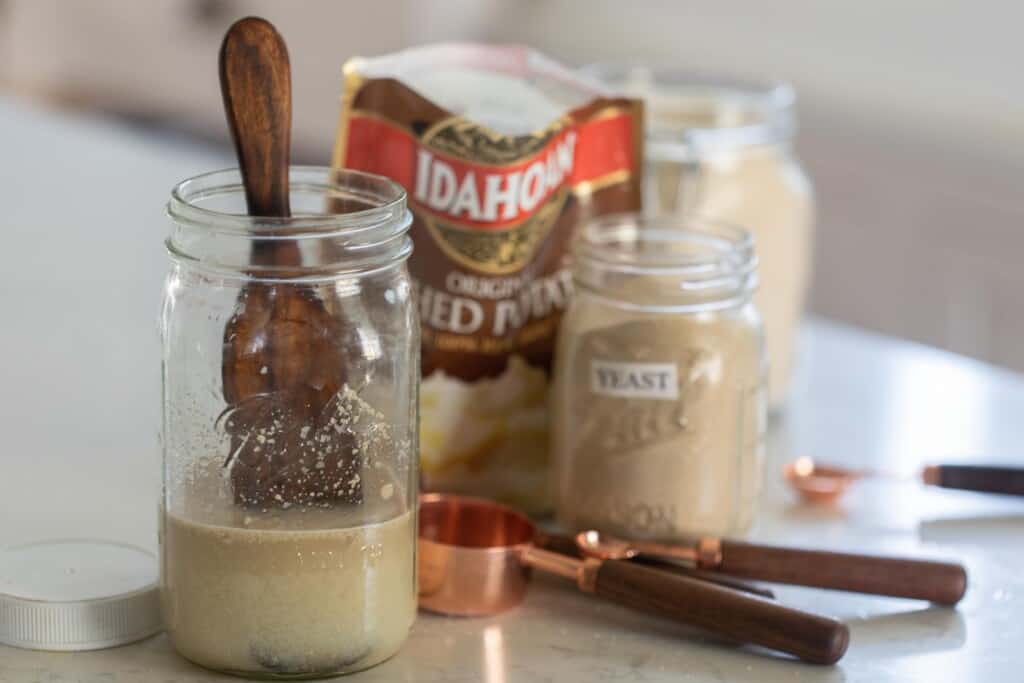
Table of Contents
- What is a potato flake sourdough starter?
- Why you’ll want a potato flake sourdough starter
- Tips for a sourdough bread starter with potato flakes
- FAQ
- Potato Flake Starter Ingredients
- How to make a potato flake sourdough starter
- How to maintain a potato flake sourdough starter
- Step-by-step instructions for maintaining your starter
- How to use your potato flake sourdough starter to make bread
- Directions:
- Check out more sourdough resources and recipes!
- Potato Flake Sourdough Starter Recipe
You know how much I love homemade sourdough bread. Sometimes, though, I do crave a sweeter bread with a little less of that signature sourdough tang and sourness.
I rarely make yeast breads. So, instead, I decided to make a potato flake starter recipe! This new starter is one of the traditional sourdough starter replacement methods.
Instead of a traditional San Francisco-style starter using flour and water, the potato flake version uses yeast, sugar, water, and dehydrated potatoes. That’s right — dehydrated potatoes!
This new starter is different from what some know as the Amish friendship bread starter (also known as southern style), although both typically use yeast to get started and include sugar.
The potato flake version gives bread a sweet taste. That’s why I love to use it on breads like sandwich bread, rolls, or even sweeter baked goods such as cinnamon rolls.
You can even use your potato flake starter discard in any of my discard recipes! This is perfect for anyone that isn’t sold on the sour in sourdough.
Today, I am going to share with you how I made my potato flake starter and how to properly care for and maintain it.
Plus, I’ve included a beginner bread recipe for you to try once your starter is ready to use! It is a take on my sourdough sandwich bread recipe with a few ingredient swaps and using potato flake starter instead of my regular starter.
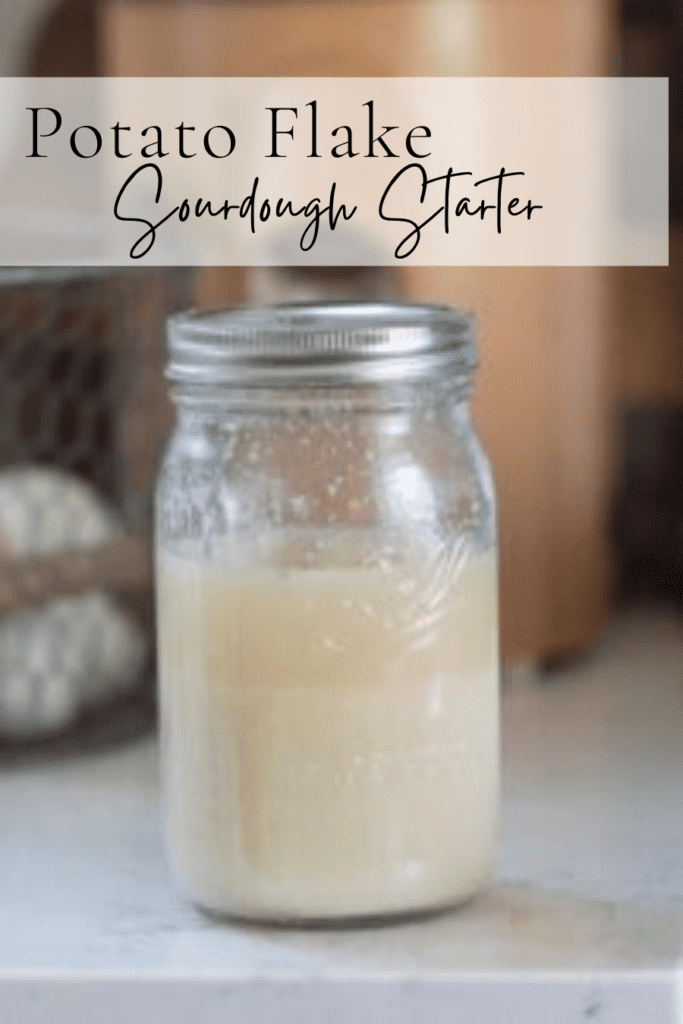
What is a potato flake sourdough starter?
A potato flake sourdough starter is made with dehydrated potato flakes, yeast, sugar, and water. When used in baking, it is what causes your bread to rise. It will give your baked goods a much sweeter taste than a traditional sourdough loaf. This starter is also gluten free and dairy free.
Note that not all yeast is gluten free. If you are strictly gluten free, you can reference this page to see what yeasts will work for you. A commercial yeast packet – active dry yeast or instant yeast – is typically considered gluten free.
This post contains affiliate links, which means I make a small commission at no extra cost to you. See my full disclosure here.
Why you’ll want a potato flake sourdough starter
A potato flake sourdough starter is fairly easy to maintain. Plus, this type of starter will result in a sweeter and less sour taste in your final product. I like it best in sandwich bread recipes or dinner rolls.
I’ve included a sourdough recipe below that is similar to my regular sandwich bread, but uses a potato flake starter instead!
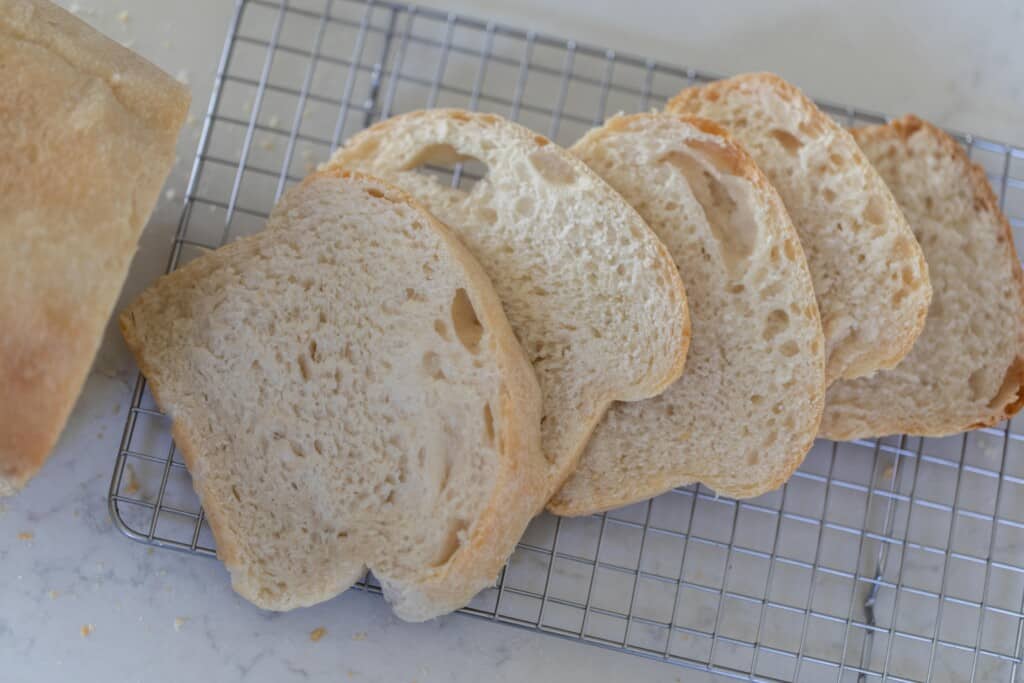
Tips for a sourdough bread starter with potato flakes
- Unlike your typical sourdough starter made with just flour and water, a potato flake starter will be a lot thinner. Of course, this will affect how much water you add to the recipe.
- If your potato flakes settle to the bottom – that is okay! It likely won’t stay incorporated, and that is normal. Simply give it a quick stir before use.
- Store your potato flake starter in the fridge. I try to feed it once a week to keep it thriving.
- If you do not want to make bread, you can discard one cup of the starter before feeding and use it in a sourdough discard recipe. My discard recipes call for traditional sourdough starter, but you can also use a potato flake starter instead. Check out some of those recipes here!
FAQ
A sourdough starter replaces the yeast in bread. It is the starter that allows bread to rise. Otherwise, your loaf would turn out flat and dense.
A traditional sourdough starter typically only uses flour and water to both create it and maintain it. A potato flake starter requires sugar, yeast, water, and potato flakes to get it started. To maintain it, you skip the yeast, but will still have to feed it sugar, water, and potato flakes! It tends to give breads a much sweeter taste than regular sourdough bread. If you’d like to learn how to make a traditional sourdough starter, click here!
It is sweeter and less sour.
Indefinitely, as long as you continue to maintain/feed it!
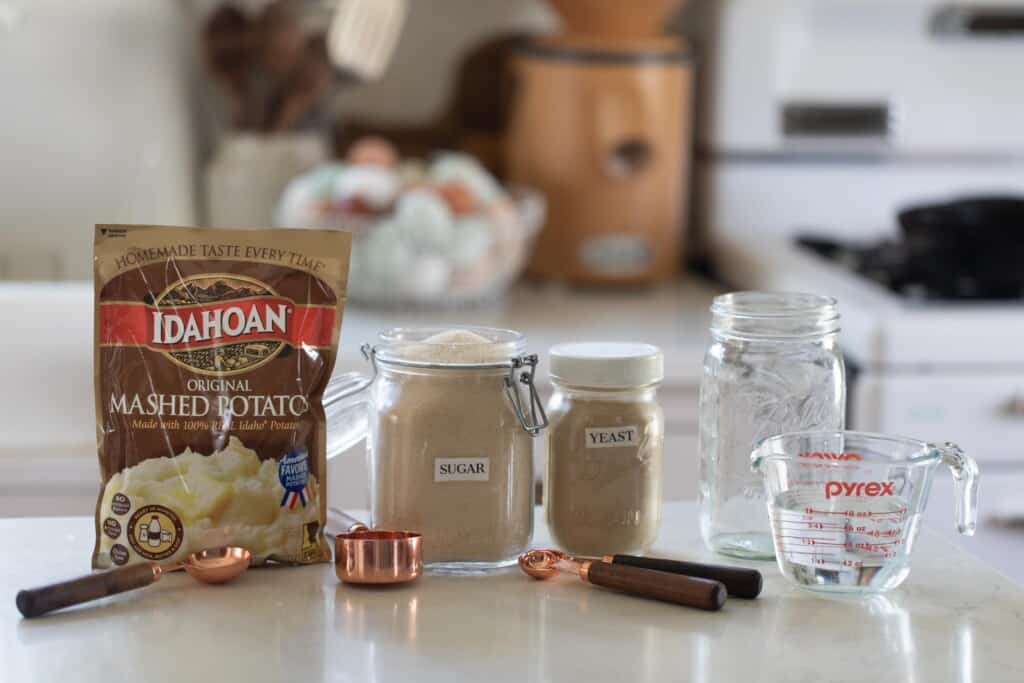
Potato Flake Starter Ingredients
This recipe will use potato flakes, sugar and commercial yeast to get it going. After it gets established, the wild yeasts will take over, and you will only have to feed it potato flakes, sugar and water.
1 cup warm water
1/4 cup sugar
1 package dry yeast (2 1/4 teaspoons)
3 tablespoons instant potato flakes
Tools to help you get started
Glass container/jar or large bowl
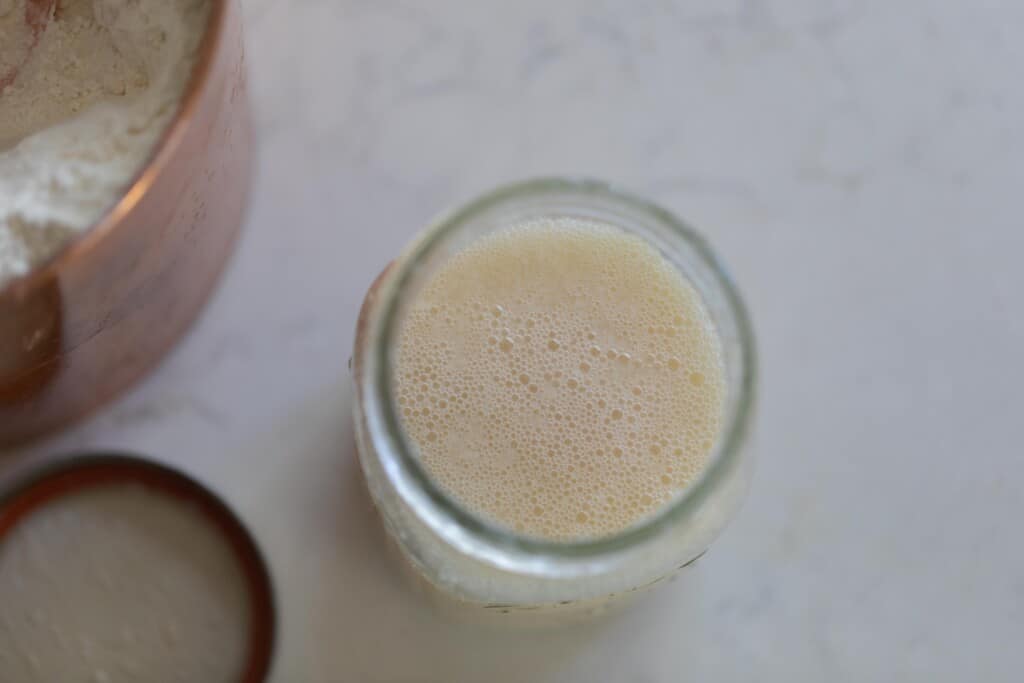
How to make a potato flake sourdough starter
- Start with a clean glass container or a large bowl.
- Add in the warm water, potato flakes, sugar and yeast.
- Stir everything together and scrape down the sides.
- Cover with something that is slightly breathable. You can use a tea towel or coffee filter with a rubber band. I like to use a flip top canister with the rubber gasket taken out or a glass jar with a glass lid. Both of these are not airtight, so the gasses (which are a natural bi product of fermentation) can escape.
- Leave it at room temperature for 4 days, stirring daily.
- On the 5th day, feed the starter with 1 cup warm water, 1/4 cup sugar and 3 tablespoons of instant potato flakes. Stir it well and allow it to sit at room temperature for 8 hours.
- Remove 1 cup of the starter to make your bread. Place the remaining starter in the refrigerator. (see instructions below to maintain for future use.)
How to maintain a potato flake sourdough starter
You maintain a potato flake sourdough starter a lot like you maintain a regular one, except you use different ingredients!
We used a package of commercial yeast to jumpstart this process originally, but you will not need it to maintain your starter.
Maintenance Ingredients
1 cup warm water
1/4 cup of sugar
3 tablespoons instant potato flakes
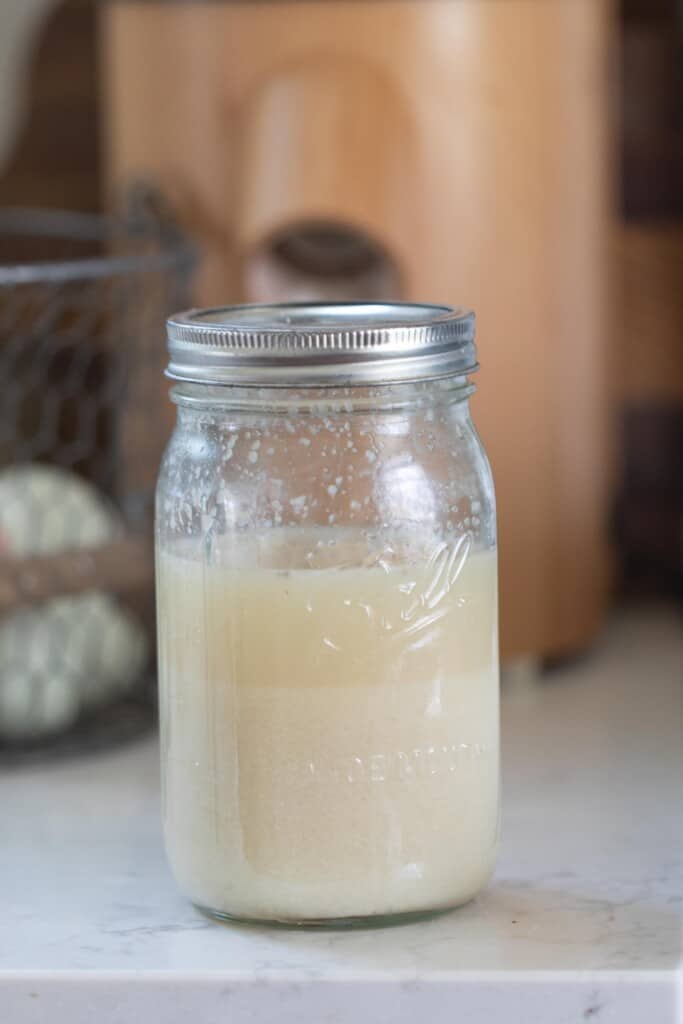
Step-by-step instructions for maintaining your starter
Remove your starter from the refrigerator, and feed it with 1 cup of warm water, 1/4 cup sugar and 3 tablespoons of instant potato flakes. Allow it to sit at room temperature for 6 hours, or until it looks bubbly and active.
Remove 1 cup of the starter to make potato flake sourdough starter bread. Put it back in the refrigerator until you want to repeat this process and make another loaf of bread.
Storing your potato flake starter in the refrigerator
Just like with a regular sourdough starter, you can store it in the refrigerator for several weeks in between uses, but it stays most active if you feed it regularly. Aim for once a week.
If you do not want to make bread, you can discard one cup of the starter before feeding and use it in a sourdough discard recipe. My discard recipes call for traditional sourdough starter, but you can also use a potato flake starter instead. Check out some sourdough discard recipes here.
How to use your potato flake sourdough starter to make bread
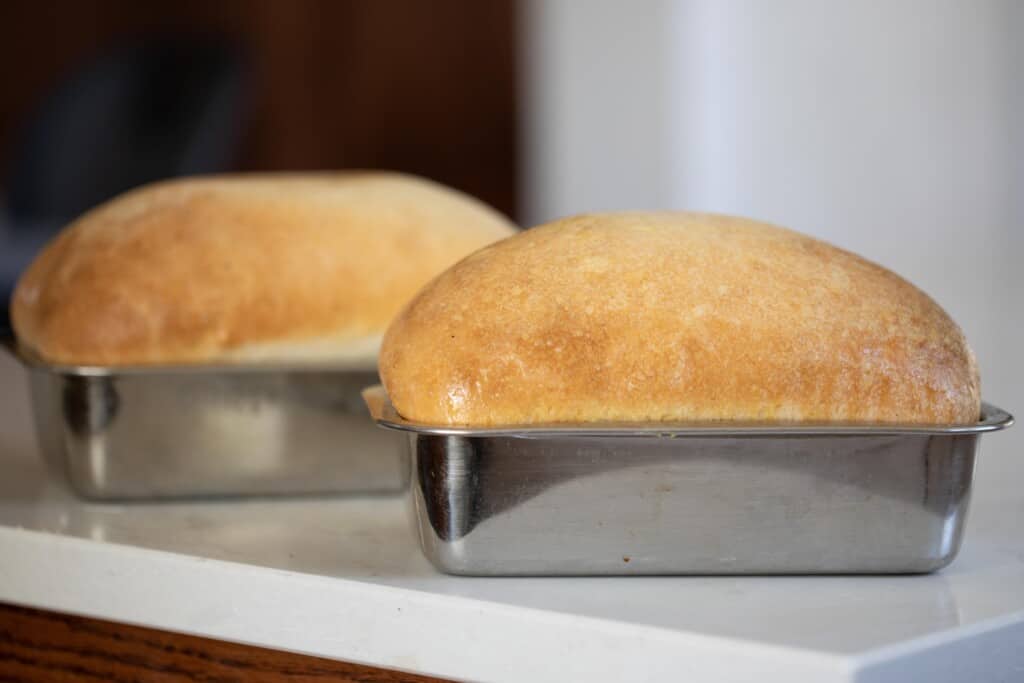
Ingredients
1/2 cup butter (softened) or coconut oil (113 g)– Use coconut oil if you are making this dairy-free or simply like more of a coconut taste.
1/2 cup sugar (96 grams)
1 tbs salt (17 grams) – I use a tablespoon salt, and prefer to use sea salt if possible!
1 cup potato flake sourdough starter (275 g), active and bubbly, active and bubbly
2 1/4 cups water (531 g)
8 cups all purpose flour (1200 g)
Tools you may need
Measuring cups and spoons (or a kitchen scale)
9.5 in by 5 in Loaf pans
Directions:
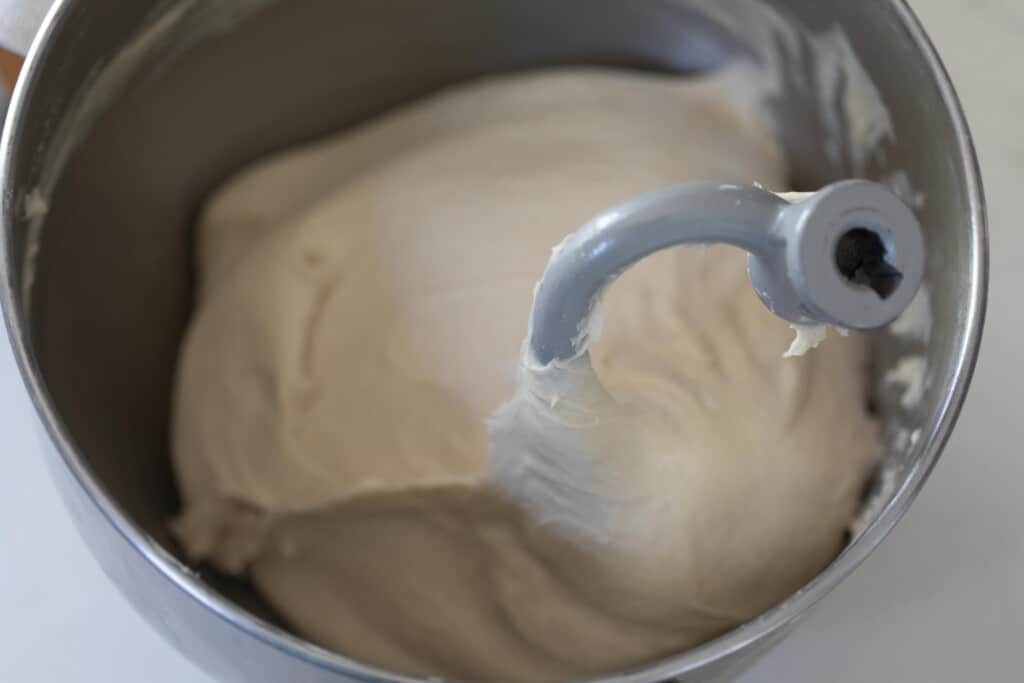
Mix ingredients
Add all of the ingredients to a stand mixer. I recommend adding the flour last. This way you can add more or less as needed, pending your starters hydration level.
Knead the dough
Turn on your stand mixer and knead the dough until it is stretchy and smooth. It will take about 10 minutes. When it is ready, it will pull away from the sides of the bowl and be elastic and smooth.
Make sure it passes the windowpane test! Grab a small ball of the dough and stretch it into a square. It should stretch thin enough to see through without breaking.
Bulk Rise
In a warm place, allow your dough ball to bulk rise for 10-12 hours. You can go longer if you want the benefit of the fermentation. However, don’t overproof! It will turn your dough into a sloppy mess.
Shape and rise
Prepare two loaf pans by either greasing them or adding pieces of parchment paper.
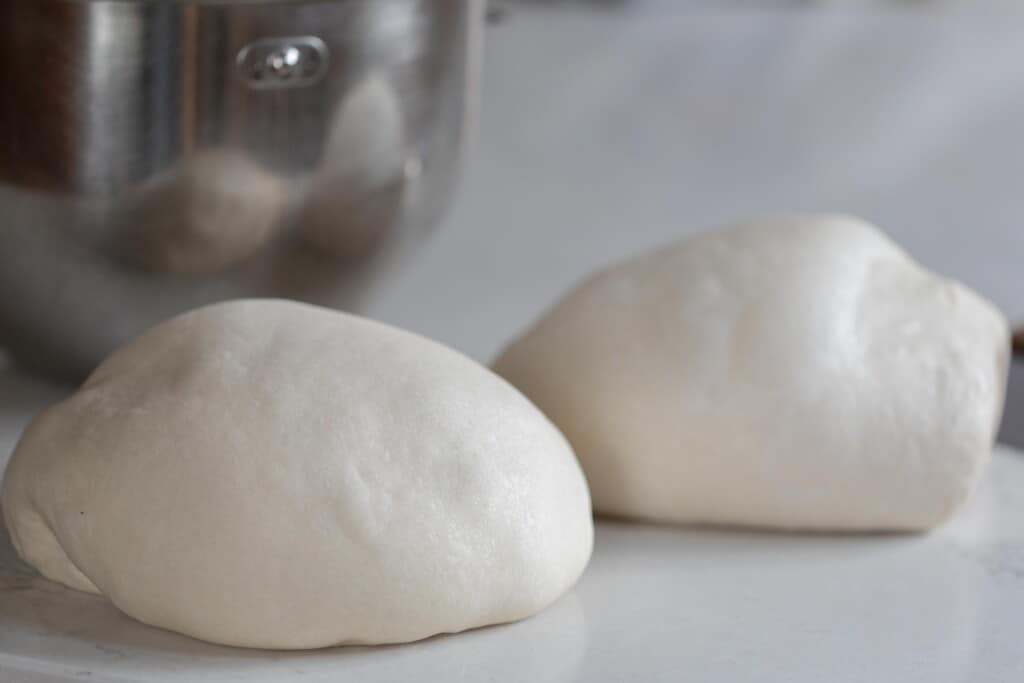
Divide dough into two equal parts.
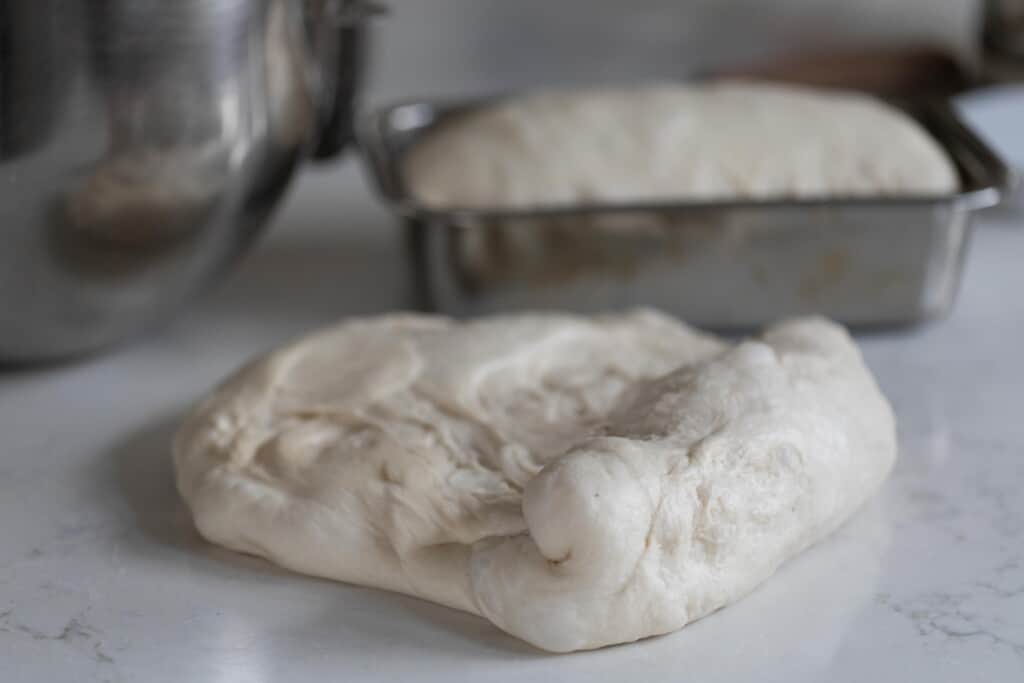
To shape your dough, roll it out flat into a rectangle and then roll it up.
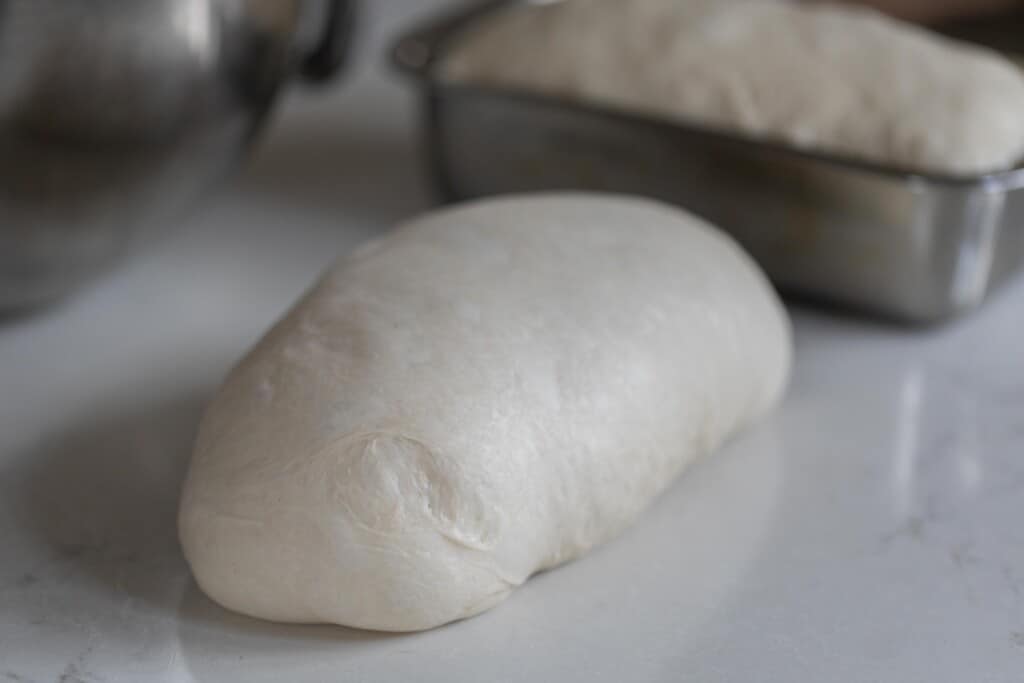
Allow to rise again for 2- 4 hours at room temperature or until doubled. The amount of time all depends on the temperature of your home.
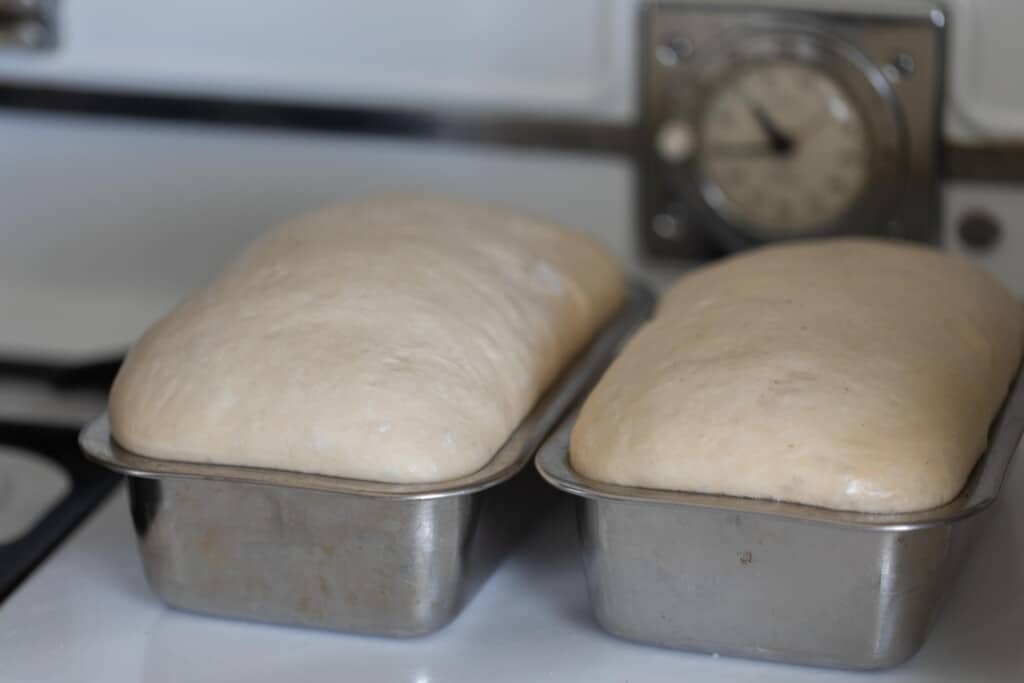
Bake
Optional: Add an egg wash on top of the loaves before baking. This provides more browning.
Bake at 375 for 45 minutes, or until golden on top.
Allow to cool completely before slicing.
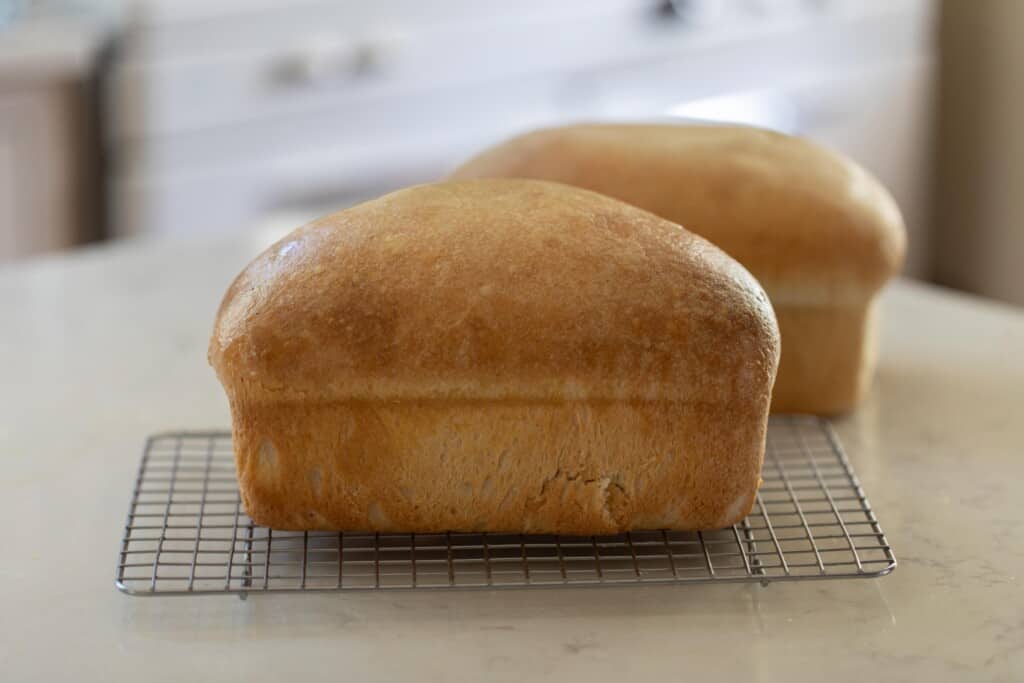
Check out more sourdough resources and recipes!
- Learn how to make a traditional sourdough starter
- How to maintain a traditional sourdough starter
- Gluten Free Sourdough Starter
- Sourdough Cinnamon Rolls
- Sourdough Dinner Rolls
If you try this recipe and love it, I would love it if you gave it 5 stars! Thank you! Tag me on Instagram @farmhouseonboone.
Potato Flake Sourdough Starter
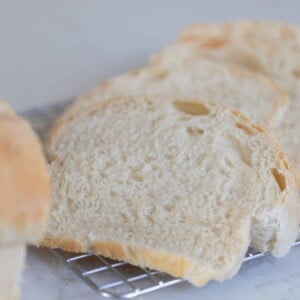
Ingredients
- 1 cup warm water
- 1/4 cup sugar
- 1 package dry yeast, 2 1/4 teaspoons
- 3 tablespoons instant potato flakes
Instructions
- Start with a clean glass container or a large bowl.
- Add in the warm water, potato flakes, sugar and yeast.
- Stir everything together and scrape down the sides.
- Cover with something that is slightly breathable. You can use a tea towel or coffee filter with a rubber band. I like to use a flip top canister with the rubber gasket taken out or a glass jar with a glass lid.
- Both of these are not airtight, so the gasses (which are a natural bi product of fermentation) can escape.
- Leave it at room temperature for 4 days, stirring daily.
- On the 5th day, feed the starter with 1 cup warm water, 1/4 cup sugar and 3 tablespoons of instant potato flakes. Stir it well and allow it to sit at room temperature for 8 hours.
- Remove 1 cup of the starter to make your bread. Place the remaining starter in the refrigerator.
Maintaining The Starter
- Remove your starter from the refrigerator, and feed it with 1 cup of warm water, 1/4 cup sugar and 3 tablespoons of instant potato flakes.
- Allow it to sit at room temperature for 6 hours, or until it looks bubbly and active.
- Once bubbly, it can be used in bread recipes.
- Keep stored in the fridge between uses. Feed every 3-5 days
Notes
Nutrition
Nutrition information is automatically calculated, so should only be used as an approximation.










Hello there. I’m curious as to how to use this starter in the other recipies on the blog. Would I cut back on the liquid and add more flour? New to sourdough and would love your insight!
Unlike your typical sourdough starter made with just flour and water, a potato flake starter will be a lot thinner. Of course, this will affect how much water you add to the recipe. If you try any of the recipes with this starter, let us know how it turns out!
What do I do, discard isn’t bubbly?
Hi Lisa. Can you explain a bit further? Did you feed your starter and let it sit at room temperature for 6 hours or so?
I made this potato flake starter yesterday and after sitting out for the first day it smells really strong of alcohol. Do you think the warm water was to hot? Or is it normal to smell of alcohol?
Sorry for the delay Sarah! Did you keep up with it and feed it again on day 5? Hopefully, it turned out okay!
Hi! I’ve been working with a similar recipe for about 8 months that we found in my MIL’s stash of recipes, and my starter no longer bubbles up generously like it used to. I feed it about once a week and then bake. Should I feed it more often, or just add sugar, or just the potato flakes, or just feed it normally? Thanks for any suggestions you can give!
I am not sure why it wouldn’t be bubbling up like it used to. Maybe try feeding it normally more often and see if that helps.
OK,..so I made this bread,..first, I think I used the starter too late,..it had bubbled and then dropped,..I proofed and it at least doubled,..I kneeded it some more,..folded and stretched,..put in oven,..baked. Crust is thick and crunchy,..bread inside is dense,..gummy when eating,..how do I get fluffier bread next time? (ps: bread tastes delish,..but just too dense and gummy)Thanks for the recipe!!
When I want to use starter again,..should I use it while it is bubbly or after it has dropped? Lower temp on oven while baking to get bread to rise more and not have such a thick crust? Pls advise,..appreciate ANY feedback!! Deb M
I’m sorry that it didn’t turn out for you! Yes, you will want to use the starter when it is nice an bubbly at its peak (or right before) and before it falls. Once it has fallen it won’t make the best bread. Hope that helps.
So, Lisa,…do I discard 1 cup of starter B4 I feed? or after? If I only want to make loaf of bread,..do I halve the recipe ingredients?
If I use a regular glass jar with lid and ring does it need holes poked in the lid?
If you are storing it on the counter, I would cover it with a tea towel. Something breathable but still keeps bugs out,
Thanks so much for sharing Lisa! My sister gave me some of her potato flake starter and I started feeding it just flour and water like the traditional sourdough. Do you think this would work? Or do I need to start from scratch with a traditional sourdough starter? Thanks!
I mean I would think you should be able to convert it to a regular starter.
I’ve done this. It works!
Can the gluten free starter be made with all purpose gluten free flour. I did not see anything in your article that said gluten free all purpose flour. Want to make this recipe. Thanks
If you are looking for a gluten free starter that uses flour, I have a recipe for that here: https://www.farmhouseonboone.com/gluten-free-sourdough-starter
For this bread recipe using the potato flake starter, I don’t see why you couldn’t sub the AP flour 1 to 1 with gluten free AP.
THIS souds amazing and easy!! I hae NOt been able to get how to make traditional sourdough,..this sounds easier,..although using the yeast is sorta cheating, NO?
When you say mix the starter ingredients and leave for 4 days,..is this 4 days including the day you mixed? Or 4 full days after? I am a stickler for details like that. I also have an elongated clay baking pan,..are there different methods to folding and shaping? Hope you can answer my questions,….I have made my starter today!! Looking forward to the sweet smell of fresh baked bread in the house!!!!
It’s 4 days after you mix it. So, if you put it together Monday at 8 p.m., Friday at 8 p.m. would be 4 days. So, you could do the other feeding on Saturday. Hope that helps. I have not used the clay baking pans, so I am not sure. Good luck!
Can I use milled flour for this bread in place of AP flour?
That should work just fine.